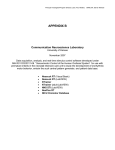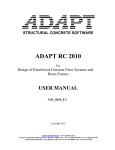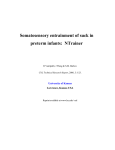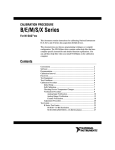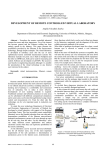Download NeoSuck RT
Transcript
Automatic analysis of non-nutritive suck in time and frequency domain among preterm infants: NeoSuck RT R Vantipalli, J Wang & S.M. Barlow CNL Technical Research Report, 2006, 5:1-18. University of Kansas Lawrence, Kansas USA Reprint available at www.ku.edu/~cnl NeoSuck RT CNL U of Kansas Table of contents 1 2 NeoSuck RT Setup ......................................................................................................... 3 1.1 Hardware................................................................................................................ 3 1.2 Software ................................................................................................................. 4 1.3 Program installation............................................................................................... 5 User manual ................................................................................................................... 8 2.1 Record new data by NeoSuck RT.......................................................................... 8 2.2 Analyze existing data by NeoSuck RT ................................................................ 10 2.2.1 Basic analysis................................................................................................... 10 2.2.2 Fourier transform of suck pressure .................................................................. 12 2.2.3 Other analysis tools.......................................................................................... 15 2.3 3 Other setups ......................................................................................................... 16 References.................................................................................................................... 18 2 NeoSuck RT CNL U of Kansas 1 NeoSuck RT Setup NeoSuck RT (real time) is used to record and analyze data associated with the non-nutritive suck (NNS), including signals related to Suck Pressure, EMG OOS-R, EMG OOS-L, EMG OOIR, EMG OOI-L, which are recorded from 5 channels of NI DAQ 6052E PCI multifunction board installed in the acquisition PC with 3 kHz sampling rate on 16-bits vertical resolution. We currently apply this software and hardware system to test and re-analyze the suck pressure and signals from other channels for premature and term baby. The analysis tools in NeoSuck RT include histogram analysis, FFT analysis, bad block screening, digital signal processing, generate output ASCII files for time and frequency domain, etc. 1.1 Hardware The Hardware for this testing equipment includes: Æ A CPU with 1 GB RAM running Windows XP Æ NI DAQ 6052E and BNC 2110 or BNC 2090 Æ Bridge Amplifier Æ AC PreAmplifiers (4) Æ Sensors: pressure sensor and EMG Ag/AgCl sensors The hardware listed above is configured up according to Figure 1, and baby’s suck pressure and EMG signal sampled from the Soothie™ silicon nipple receiver is input to NeoSuck RT for real time digitization, signal processing, and waveform display. 3 NeoSuck RT Suck Pressure Ai3 Computer and DAQ EMG Ai4-7 Bridge Amplifier LPF 50Hz Grass AC PreAmplifiers CNL U of Kansas Suck Pressure Ai3 Pressure Transducer Suck Pressure Ai3 EMG Ai4-7 EMG Sensor EMG Ai4-7 GND is connected to baby leg Dec 1, 2005 by Joan Figure 1. Hardware configuration for NeoSuck RT 1.2 Software This software is coded by Visual Basic.Net (17,265 coding lines) according to the structure shown in Figure 2. The function of this software includes real-time data acquisition, histogram processing, FFT analysis, ASCII file generation, and export desired data to .txt file. 4 NeoSuck RT Structure Plot of NeoSuck File CNL U of Kansas New frmMain.vb mnuFileNew(): Name a new .dat file Open frmMain.vb mnuFileOpen():Open an existing .dat file Page Setup frmMain.vb mnuFilePageSetup() Print Exit frmPrintSelection.vb dummy frmMain.vb mnuPrintAmplitudeHist(), etc. frmMain.vb mnuFilePageSetup() DAQ frmSettingsDAQ.vb Graph frmSettingsGraph.vb 8*AI calibration settings for DAQ board Y Axis scale setting for 8*AI plots Settings Histgram Suck Pr Analysis frmSettingsHist.vb scale setting for Histogram of Amplitude, Pause, and Burst Period frmSettingsPeak.vb Peak selection settings for suck pressure plot NeoSuck Select Baseline frmMain.vb Histogram Tools Amplitude frmAmplitudeHist.vb Histogram plot of cumulative amplitude Pause Period frmBurstPauseHist.vb Burst Period frmDerivative.vb Bad Block List frmAddRemoveBlocks.vb Histogram plot of cumulative bust Histogram plot of cumulative pause Bad block list selection dialog Filter frmSuckFFTSettingsFilter.vb HPF LPF Graph frmSuckFFTSettingsGraph.vb Scale settings Settings SuckFFT frmSuckFFT.vb Create ASCII Blocks Tools Generate Composite frmMain.vb mnuToolsCreateASCII():Create data file in .txt for every block Generate Histogram Files frmMain.vb mnuToolsGenHistFiles():Create data file in .txt for histogram of amplitude, bust and pause Generate Amp-Period ASCII File frmMain.vb mnuToolsGenAmpPeriodFile():Create data file in .txt for? Convert Old Format to New Format frmMain.vb mnuToolsConvertOldToNew(): Create .txt file for? Help frmAbout.vb Nov 17, 2005 by Joan Figure 2. Coding structure plot for NeoSuck RT 1.3 Program installation 1. Uninstall any previous installed versions of NeoSuck RT using Control Panel > Add/Remove Programs. 2. Install NeoSuck RT by running setup.exe from the installation package. 5 NeoSuck RT CNL U of Kansas Figure 3. BNC-2090 Note: Normally, it works with BNC-2090 interface (Figure 3). To work with the BNC-2110 (Figure 4) please make the following change: Figure 4. BNC-2110 For BNC-2110 To work with BNC-2110, the terminal configuration has to be in differential mode. Terminal configuration can be set to differential mode by modifying the parameter value of “terminalConfig” to “1” under <systemConstants> section in the file NeoSuckRT.exe.config located in C:\Program Files\Neuro Logic\NeoSuck RT\. Here is the line from NeoSuckRT.exe.config that shows this parameter value: <add key=" terminalConfig" value="1" /> “terminalConfig” can have the following values: 6 NeoSuck RT CNL U of Kansas value="1" for Differential value="2" for Referenced single ended value="3" for Nonreferenced single ended By default, the file NeoSuckRT.exe.config contains value="3" for “terminalConfig”. This setting is used for the BNC-2090 signal interface. Here is the line from NeoSuckRT.exe.config that shows this parameter value <add key="terminalConfig " value="3" /> 7 NeoSuck RT CNL U of Kansas 2 User manual When opening the NeoSuck RT, a blank window is shown as follows (Figure 5). User could apply this set of software and hardware to record new data or analysis of existing data: Figure 5. Blank window for recording and analysis 2.1 Record new data by NeoSuck RT To Record data for a baby, go to FileÆNew, then a “Save As” file dialog will pop up as shown in Figure 6. Input the file name as *.dat file which will be used for future analysis, and click “Save” button. 8 NeoSuck RT CNL U of Kansas Figure 6. Recording new data Then user can press the “Start” to begin the recording, or “Pause” button to halt it. 9 NeoSuck RT 2.2 CNL U of Kansas Analyze existing data by NeoSuck RT Based on the data collected (described in section 2.1, Record new data by NeoSuck), user can systematically apply analysis tools in NeoSuck RT to investigate more detailed properties of the human infant NNS. 2.2.1 Basic analysis Click FileÆOpen, an open file dialogue will pop up (Figure 7) to enable the user to designate the name and path of the target data file. Figure 7. Opening an existing data file Figure 8 shows the initial NeoSuck RT data analysis window. The three histogram windows on the right display the histogram plots for NNS Amplitude, Pause Periods, and NNS Burst Periods for each block that the user has selected. If the user is only interested in the analysis 10 NeoSuck RT CNL U of Kansas of data from 8 channels displayed in the main window, then these three histogram windows can be closed by the user. Figure 8. Open NeoSuck RT window for data analysis The User can also call these windows by clicking desired window in ToolsÆHistogram as shown in Figure 9. Furthermore, the displayed histograms can also be exported to *.txt file by clicking ToolsÆGenerate Histogram Files for future analysis. Those files will be saved under C:\Program Files\Neuro Logic\NeoSuck RT\Data. 11 NeoSuck RT CNL U of Kansas Figure 9. NeoSuck window without Histogram analysis Similar to the recording process, NeoSuck RT analyzes data in successive blocks (30 seconds for each block). User can scroll among different blocks by clicking the “Previous” and “Next” buttons in the lower part of the window as shown in Figure 9. NeoSuck RT is mainly for suck pressure analysis, which is shown as the last graph in the first column. NeoSuck RT can automatically recognize the peak in suck pressure, which is marked by small diagonal red lines in suck pressure plot. 2.2.2 Fourier transform of suck pressure NeoSuck RT can be used to calculate the FFT of suck pressure. In order to get the frequency property of suck pressure, the user can click ToolsÆSuck FFT to call up the “FFTSuck Pressure” window. In this analysis window, the user will find the time domain and 12 NeoSuck RT CNL U of Kansas frequency domain plot of the currently displayed block in the main NeoSuck RT window (Figure 10). The first and second graphs are both for current block, while the third graph, named as composite FFT, shows the mean FFT for all the blocks that have been analyzed by the FFT subroutine. User could either click “Update FFT Plot/Save FFT” button, or go to ToolsÆGenerate Composite in this window to periodically update the composite FFT. Figure 10. Suck pressure FFT analysis In the setting menu, user could set the filter parameters (cutoff frequencies for Low Pass filter and High Pass filter) to plot the desired frequency property (Figure 11). In addition, the graph setting (Figure 12) enables the user to define the minimum and maximum values for both xaxis and y-axis for each of the three graphs shown in this window. 13 NeoSuck RT CNL U of Kansas Figure 11. Filter setting in FFT analysis Figure 12. Graph setting in FFT analysis 14 NeoSuck RT CNL U of Kansas 2.2.3 Other analysis tools There are some other analysis tools embedded in NeoSuck RT to either display graphs or export *.txt files which could be used for extended analyses using other commercial software like Minitab™, LabVIEW™, MATLAB™, MS Excel™, etc. 1. ToolsÆBad Block List (Figure 13) enables the user to delete bad blocks from the entire data set, and thus generate clean analysis data for both exported data and Fourier transform analysis. Figure 13. Bad Block List 2. ToolsÆCreate ASCII Blocks (Figure 14) performs the function of exporting recorded *.dat file to .txt file block by block. The *.dat is a binary file which can be read by Visual Basic. The purpose of transforming data into *.txt file is to make the recorded data readable by 3rd party commercial graphics and statistical software. Figure 14. Create ASCII blocks for .dat file 3. The “Generate Histogram Files” and “Generate Amp-Period ASCII Files” will generate *.txt files for future analysis. 15 NeoSuck RT 2.3 CNL U of Kansas Other setups Some other setups in Setting of the NeoSuck RT menu bar enable the user to set and modify analysis criteria for data acquisition, graphs, histogram plots, and FFT analysis. Figure 15 is the DAQ setting dialog where the user can adjust the minimum and maximum acquisition limits, as well as calibration parameters. Once the DAQ parameters are set, sampled data files will assume the format established in the DAQ set-up. Thus, these setup parameters should not be modified unless the specific intent is to change file structure and sampling rates. Figure 15. DAQ board settings The Graph and Histogram settings (Figure 16) include the dialog windows for lower and upper limit selection according to user’s preference. 16 NeoSuck RT CNL U of Kansas Figure 16. Graph and Histogram setting dialogue The “Suck Pr Analysis” setting (Figure 17) defines parameters for peak selection, and suck pressure threshold value for recording, etc. Figure 17. Suck Pr Analysis setting 17 NeoSuck RT CNL U of Kansas 3 References Estep, M., Barlow, S.M., Stumm, S. Fees, M., Finan, D., Seibel, L. Poore, M., Cannon, S. (2005). Non-nutritive Suck Burst Parametrics in Preterm Infants, Society for Pediatric Research, 2141. Seibel, L., Barlow, S.M., Vantipalli, R., Finan, D., Urish, M., Carlson, J. (2005). Spectral Dynamics of Non-Nutritive Suck in Preterm Infants, Society for Pediatric Research, 2139. Stumm, S., Barlow, S.M., Vantipalli, R. Finan, D., Estep, M., Seibel, L., Urish, M., & Fees, M. (2005). Amplitude/Burst Dynamics of the Non-Nutritive Suck in Preterm Infants. Society for Pediatric Research, 2632. Zimmerman, E., Barlow, S.M., Seibel, L., Poore, M., Stumm, S., Estep, M., Chu, S., Fees, M., Urish, M., Gagnon, K., Cannon, S., Carlson, J. (2006). Pacifier stiffness alters the dynamics of the suck central pattern generator. Society Pediatric Research, 5571:393. Stumm S, Barlow S, Vantipalli R, Finan D, Estep M, Seibel L, Urish M, Fees M, Poore M, Chu S, Zimmerman E, Cannon S, Gagnon K, Carlson J. (2006) Amplitude-Burst dynamics of the non-nutritive suck in preterm infants. J Clinical Nursing, (under revision). Estep M, Barlow SM, Stumm S, Fees M, Finan D, Seibel L, Poore M, Cannon S. (2006). Nonnutritive Suck Burst Parametrics in Preterm Infants with Respiratory Distress Syndrome. Biol Neonate, submitted. 18


















